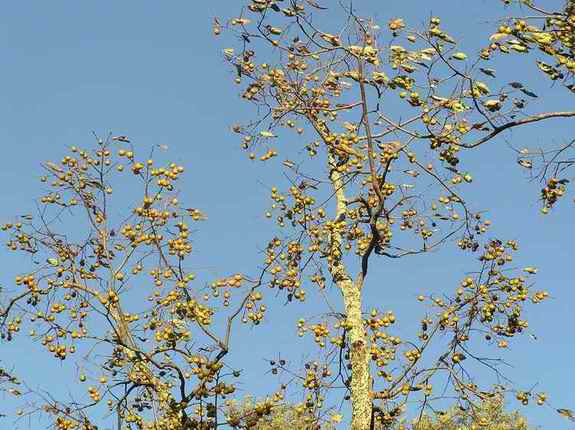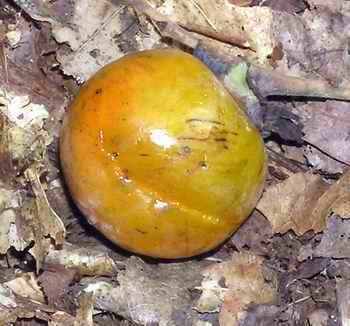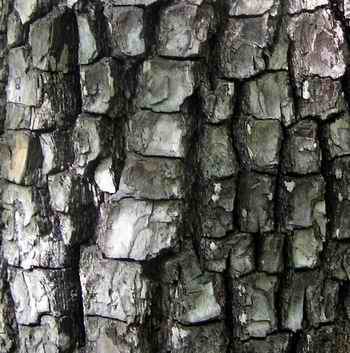|
Return to Hiker's Notebook Home Page
Common Name: Persimmon - From the Native American Algonquian word pasimenan literally meaning "fruit artificially dried" referring to the need to dry out the fruit before use in cooking due to its astringency when first picked; also called Date Plum. Scientific Name: Diospyros virginiana - Generic etymology from the Greek dios which means divine or god-like, referring to Zeus and pyros meaning grain or wheat; literally food for the gods; virginiana for the colony of Virginia where it was first discovered. The Persimmon tree gets its name from the fruit that it bears, which is its most notable and distinguishing feature. The fruit has the interesting and somewhat singular property that it is highly astringent when ripe, becoming palatable only after the first frost when the fruit becomes soft and seemingly rotten according to appearance. The lip-puckering astringency is due to polyphenolic compounds that form within specialized tannin cells during fruit development. The loss of astringency concomitant to freezing is not thoroughly understood but is generally attributed at least in part to the dilution of the polyphenolics that results when the fruit pulp freezes and the flesh expands. The astringency is also removed by heating the fruit as could readily be done by drying it in the sun, a process thought to polymerize the tannin to mitigate its effects.
The persimmon was in widespread use by Native Americans who learned to eliminate the astringent tannins by drying or freezing the fruit. Hernando De Soto and his party were offered loaves of bread made from persimmons by the Cherokee Indians near present day Memphis. According to legend, Powhatan Indians taught the early colonists that the fruit should not be eaten until the first frost but they did not understand that this meant to leave them on the tree until well into October. They choked on the astringent ripe fruit. Captain John Smith of Jamestown wrote "The fruit is like a medlar; it is first green then yellow, and red when ripe; if not ripe, it will drive a man's mouth awrie with much torment; but when it is ripe, it is as delicious as an apricock."
The persimmon fruit and other parts of the tree have medicinal properties inherent to the astringent qualities of the tannins. The Catawba Indians boiled persimmon tree bark in water and made a mouth rinse that was used to treat thrush, a fugal disease of the mouth characterized by white lesions. The leaves and fruit are rich in vitamin C and have been used as an antiscorbutic (treatment for scurvy). The astringent ripe fruit were made into a decoction to treat bloody stools. It was used as a poultice externally to treat warts. The seeds can be roasted and used as a coffee substitute, a practice that was widespread among confederate soldiers during the Civil War. The persimmon is a member of the ebony family and hence has very dense wood that is both strong and hard. Only the black locust has stronger wood and only the dogwood and the ironwood have harder wood. The small size of the persimmon precludes its use as a commercial lumber source; however it is used in a number of applications where the combination of hardness and strength are needed. It was the primary wood used for the manufacture of textile mill shuttles which needed to withstand the furious activity of the process. It is still used to make handcrafted persimmon golf club heads, which are said by aficionados to rival the high-end titanium drivers. The bark of the persimmon is uniquely patterned in a striated checkerboard appearance.
The Japanese persimmon, D. kaki, is a native of China but was introduced into Japan at a very early date, where it became the national fruit and one of the traditional foods for the New Year's celebration. Commodore Matthew Perry was commissioned by President Millard Fillmore to establish diplomatic relations with Japan in 1854 which opened Japan to the West and ultimately precipitated the collapse of the shogunate. He returned with Japanese persimmon seeds that were planted in Washington D. C. but which ultimately succumbed to frost. The interest in the Japanese persimmon persisted, however, and in 1877, five thousand plants comprising 19 different varieties were imported. The persimmons found in the supermarket are among the various cultivars of D. kaki. The names of the cultivars are testimony to their importance to Japanese culture. The Hanagosho means "flower of the imperial palace" and Hanafuyu is "winter flower." |


